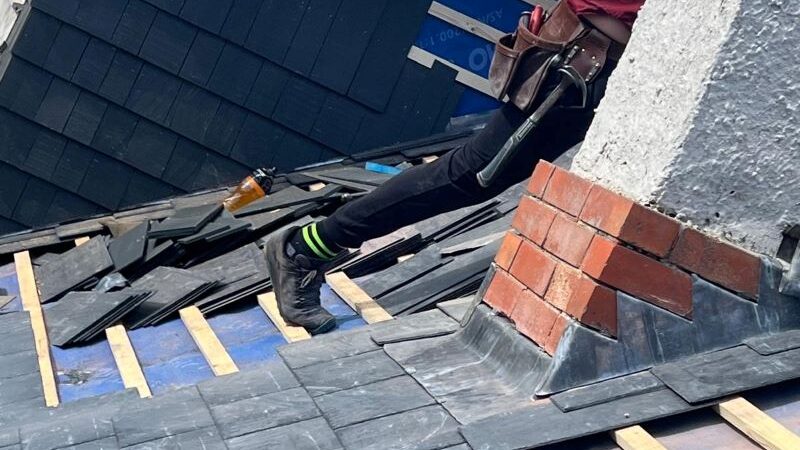Enhance Your Slate Roof’s Lifespan by Installing Quality Flashing to Prevent Expensive Leaks
Flashing serves as an essential protective barrier at the most susceptible points of your roof, particularly where tiles intersect with walls, chimneys, or valleys. Without the installation of adequate flashing, even a meticulously installed slate roof may develop leaks over time, leading to costly repairs. lead is commonly chosen for flashing in slate roofing because of its flexibility, outstanding durability, and capacity to accommodate the natural movements of the roof structure, thereby ensuring a secure seal that effectively prevents water infiltration.

Understanding Flashing and Its Essential Role in Protecting Your Slate Roof
Flashing is the vital component used to seal joints and edges around structures like chimneys, skylights, roof valleys, and any intersection where your slate roof meets a wall or shifts direction. These joints are particularly susceptible to water infiltration, and without effective flashing in place, they are likely to be the first points of failure, resulting in leaks. In contemporary construction, flashing may be crafted from sheet metals; however, for traditional applications on slate roofs, lead remains the superior choice.
What makes lead the preferred material? This substance not only seals effectively but also molds to create a strong barrier against various contours, slopes, and edges. It naturally expands and contracts with shifts in temperature without the risk of cracking or splitting. Unlike synthetic alternatives, lead is resistant to rust and maintains its integrity significantly longer, often outlasting the slate itself.
Understanding the Consequences of Flashing Failure
Even the tiniest tear or gap in your flashing can lead to substantial leaks. These leaks are rarely straightforward; water can seep beneath the tiles, reach the underlay, and gradually result in issues such as rot, mold, or damage to your internal ceilings. The effects of flashing failure may not be immediately apparent, often taking years to reveal themselves, and by then, the repairs can become extensive and financially burdensome. Issues related to flashing are among the leading causes of hidden roof failures.
If you spot stains on your ceiling, bubbling paint near a chimney, or patches of moss accumulating in specific areas on your roof, deteriorating flashing could be the underlying problem.
Why Lead Remains the Optimal Choice for Roofing Flashing Materials
For centuries, lead has been the material of choice for slate roofs due to its distinct properties. It is recyclable, incredibly durable, and capable of withstanding harsh weather conditions, whether it be intense heat or severe storms. The malleability of lead allows it to fit closely without causing damage to the delicate slate, which is relatively fragile compared to lead.
Common applications for lead flashing include:
- Chimney flashings (both step and apron)
- Roof valleys
- Secret gutters
- Roof-to-wall junctions
- Ridge and hip intersections
- Skylight surrounds
These areas experience movement, pressure, and water runoff, making them particularly prone to failure when utilizing hard, inflexible materials that can crack or dislodge.
Determining When to Replace or Repair Your Lead Flashing
While lead flashing is typically long-lasting, it will eventually show signs of wear and tear. Consider replacement if you observe:
- The lead has developed splits or cracks
- It is lifting or curling away from the roofline
- Rust is evident, particularly where lead meets other metals
- Water stains are visible inside your home
- You are planning a slate roof repair or rebuild
Most slate roof restorations include a comprehensive inspection of all leadwork. If we are already on your roof for tile replacement or cleaning, that is the ideal moment to evaluate and replace flashing as necessary.
The Importance of Relying on Skilled Craftspeople for Leadwork
Leadwork is a specialized craft that should not be entrusted to just any general roofer or handyman. Improperly installed lead can sag, split, or detach from the slate, negating the advantages of a well-constructed slate roof. Our expert team employs traditional techniques for installing lead flashing, ensuring accurate sizing, proper lap joints, and expansion joints that accommodate the weather fluctuations typical in Sydney. We are committed to using lead only where it is the most appropriate material for the job.
How High-Quality Flashing Can Reduce Future Roofing Problems
A slate roof can endure for a century or more, but only if its most vulnerable points are properly protected. Flashing and leadwork may not be the most glamorous aspects of a roof, yet they are critical components that shoulder the burden when weather conditions become severe. If you notice leaks, streaks, or signs of wear around your chimney or roof edges, it is imperative to have it evaluated without delay. Replacing flashing now can save you from incurring much higher repair costs for structural damage in the future.
Are You Seeking a Professional Inspection for Your Leadwork?
If your slate roof features flashing that has deteriorated or is exhibiting signs of wear, it is prudent to have it inspected before minor issues escalate into costly damage. Reach out to us today to schedule an evaluation with a team that specializes in slate, lead, and the intricate details that effectively hold your roof together.
Common Questions Regarding Flashing and Leadwork Explained
What Exactly Is Flashing on a Slate Roof and Why Is It Crucial?
Flashing is the material used to seal joints and transitions in the roof—such as around chimneys, valleys, and skylights—preventing water from entering the roofing structure.
What Makes Lead the Preferred Material for Slate Roof Flashing?
Lead is flexible, exceptionally durable, and resistant to varying weather conditions. It conforms to the shapes of slate tiles and outlasts synthetic materials, establishing it as the ideal option for flashing.
What Is the Expected Lifespan of Lead Flashing?
With proper installation, lead flashing can last for 50 years or more, frequently outliving the slate roof it safeguards.
Can Flashing Be Repaired Without Replacing the Entire Roof?
Yes, damaged or worn flashing can be repaired or replaced without necessitating a complete slate roof replacement, provided the issues are addressed promptly and effectively.
What Are the Signs of Flashing Failure?
Indicators of flashing problems include water stains near chimneys, damage to ceilings, moss growth in isolated areas, or visible gaps where roof surfaces meet. Addressing these issues quickly can prevent further damage.
Do All Slate Roofs Require Lead Flashing?
Most slate roofs do require flashing. Areas such as chimneys, valleys, and wall junctions necessitate flashing, with lead being the preferred material due to its compatibility with slate.
Is It Safe to Use Lead Flashing in Residential Properties?
Absolutely, when installed by professionals, lead flashing poses no safety risks. It remains the most effective and traditional choice for slate roofs, ensuring long-lasting protection.
The Article: Leadwork and Flashing: Why It’s Crucial for a Slate Roof first appeared on https://writebuff.com
The Article Leadwork and Flashing: The Importance for Slate Roofs Was Found On https://limitsofstrategy.com

